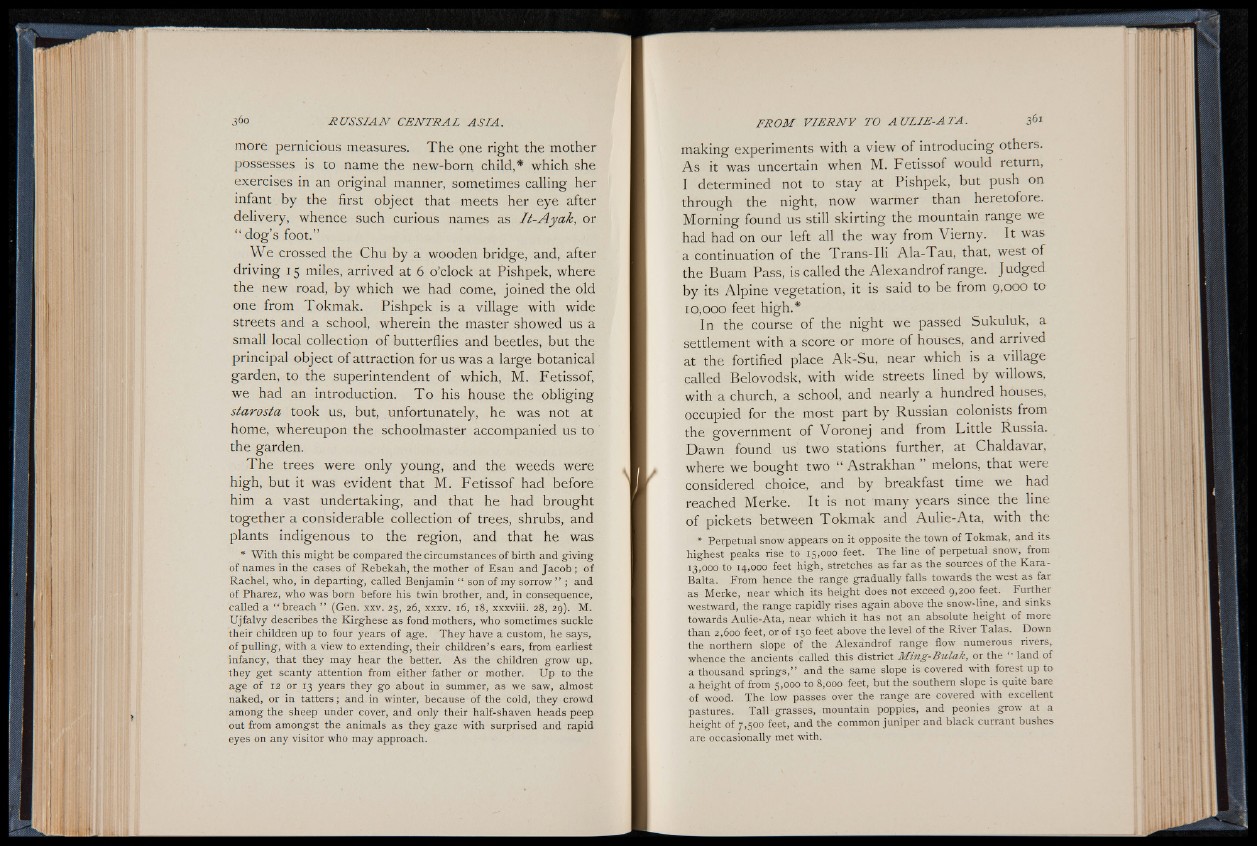
more pernicious measures. The one right the mother
possesses is to name the new-born child,* which she
exercises in an original manner, sometimes calling her
infant by the first object that meets her eye after
delivery, whence such curious names as It-Ayak, or
|d o g ’s foot.”
We crossed the Chu by a wooden bridge, and, after
driving x 5 miles, arrived at 6 o’clock at Pishpek, where
the new road, by which we had come, joined the old
one from Tokmak. Pishpek is a village with wide
streets and a school, wherein the master showed us a
small local collection of butterflies and beetles, but the
principal object of attraction for us was a large botanical
garden, to the superintendent of which, M. Fetissof,
we had an introduction. T o his house the obliging
starosta took us, but, unfortunately, he was not at
home, whereupon the schoolmaster accompanied us to
the garden.
The trees were only young, and the weeds were
high, but it was evident that M. Fetissof had before
him a vast undertaking, and that he had brought
together a considerable collection of trees, shrubs, and
plants indigenous to the region, and that he was
* With this might be compared the circumstances o f birth and giving
of names in the cases of Rebekah, the mother of Esau and Jacob ; o f
Rachel, who, in departing, called Benjamin “ son of my sorrow ” ; and
of Pharez, who was born before his twin brother, and, in consequence,
called a “ breach ” (Gen. xxv. 25, 26, xxxv. 16, 18, xxxviii. 28, 29). M.
Ujfalvy describes the Kirghese as fond mothers, who sometimes suckle
their children up to four years of age. They have a custom, he says,
of pulling, with a view to extending, their children’ s ears, from earliest
infancy, that they may hear the better. A s the children grow up,
they g e t scanty attention from either father or mother. Up to the
a g e of 12 or 13 years they go about in summer, as we saw, almost
naked, or in ta tte r s ; and in winter, because of the cold, they crowd
among the sheep under cover, and only their half-shaven heads peep
out from amongst the animals as they gaze with surprised and rapid
eyes on any visitor who may approach.
making experiments with a view of introducing others.
As it was uncertain when M. Fetissof would return,
I determined not to stay at Pishpek, but push on
through the night, now warmer than heretofore.
Morning found us still skirting the mountain range we
had had on our left all the way from Vierny. It was
a continuation of the Trans-Ili Ala-Tau, that, west of
the Buam Pass, is called the Alexandrof range. Judged
by its Alpine vegetation, it is said to be from 9,000 to
10.000 feet high.*
In the course of the night we passed Sukuluk, a
settlement with a score or more of houses, and arrived
at the fortified place Ak-Su, near which is a village
called Belovodsk, with wide streets lined by willows,
with a church, a school, and nearly a hundred houses,
occupied for the most part by Russian colonists from
the government of Voronej and from Little Russia.
Dawn found us two stations further, at Chaldavar,
where we bought two “ Astrakhan ” melons, that were
considered choice, and by breakfast time we had
reached Merke. It is not many years since the line
of pickets between Tokmak and Aulie-Ata, with the
* Perpetual snow appears on it opposite the town of Tokmak, and its
highest peaks rise to 15,000 feet. The line of perpetual snow, from
13.000 to 14,000 feet high, stretches as far as the sources of the Kara-
Balta. From hence the range gradually falls towards the west as far
as Merke, near which its height does not exceed 9,200 feet. Further
westward, the range rapidly rises again above the snow-line, and sinks
towards Aulie-Ata, near which it has not an absolute height of more
than 2,600 feet, or o f 150 feet above the level of the River Talas. Down
the northern slope of the Alexandrof range flow numerous rivers,
whence the ancients called this district Mmg-Bulo>k, or the land of
a thousand springs,” and the same slope is covered with forest up to
a height of from 5,000 to 8,000 feet, but the southern slope is quite bare
of wood. The low passes over the range are covered with excellent
pastures. TalT grasses, mountain poppies, and peonies grow at a
height of 7,500 feet, and the common juniper and bla ck currant bushes
are occasionally met with.